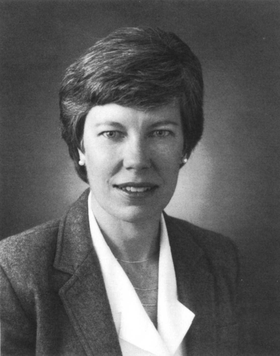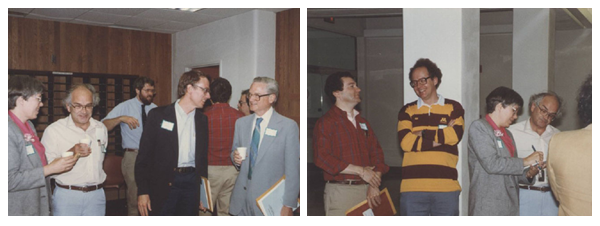- History Home
- People, Leadership & Service
- A Legacy of Excellence
- History & Impact
- Meetings Through the Years
- Resources
Biography - Margaret C. Etter (1943 - 1992)Biography | Publications | Curriculum Vitae | Videos | Slides | Articles | Obituary Margaret C. Etter, Professor of Chemistry at the University of Minnesota and one of the coordinating editors of Molecular Engineering, died June 10, 1992 of cancer. She was a charming person, an excellent lecturer, and an outstanding scientist. No one knew her for more than five minutes without calling her Peggy. She was the kind of person who made a lasting impression on virtually everyone who made her acquaintance.
Photo Left: Mark Hollingsworth & Margaret Etter [Photography Credit Unknown]
Photo Right: Margaret Etter [Photography Credit Unknown]
Peggy had a wonderful sense of humor. Her students, colleagues, and friends knew her fun-loving streak, characterized by a singular laugh that easily echoed across the room or down the hall. A few of us will remember the scented smiley stickers or the giant-sized $100 bills we received to reward some research results, a well-presented seminar, or a truly original idea. She was a very down-to-earth person, who did not take herself too seriously. After an excess of sexist verbal transgressions during one of her group meetings, her old friend Joel Bernstein was awarded “The Book on Nonsexist Writing.” She was a Phi Beta Kappa graduate of the University of Pennsylvania and received a master’s degree in chemistry from the University of Delaware prior to beginning graduate studies at the University of Minnesota, where she received a Ph.D. in chemistry for her work on topotactic reactions under the direction of Jack Gougoutas. Upon leaving the chemistry department in 1975, Peggy taught organic chemistry at Augsburg College in Minneapolis for one year, after which she joined the 3M Company’s Central Research Laboratory in St. Paul as a research chemist. At 3M she was involved in projects ranging from polymer chemistry to hydrogen bonding in organic solids. Peggy set about establishing an organic solid-state chemistry group which ultimately included Ruth Kress Johnson and William (Bill) Gleason. Peggy didn’t just talk, she did things: things that were not necessarily popular at the time. She helped to establish the 3M Visiting Women’s Scientist program, the purpose of which was to encourage female students to consider science as a career. She was also a director and instructor in the STEP program, directed at encouraging minority students to become scientists.
Photo Left: (from left to right) Peggy Etter, Iain Paul, Mark Hollingsworth (background), Steve Bryrm, Joe Dannenburg (background) and David Curtin [Photography Credit Unknown]
Photo Right: (from left to right) Craig Eckhardt, Bill Gleason, Peggy Etter, Iain Paul and Joe Dannenberg [Photography Credit Unknown]
A belated postdoctoral stint in solid-state NMR provided the final intellectual ingredient and catalyzed the extraordinary burst of creativity and productivity that characterized Peggy’s academic career. She returned to the chemistry department at the University of Minnesota in 1983, where she made rapid progress from assistant to full professor in 1990. There she received a Sloan Foundation award and obtained research support from the NSF, the NIH, and the Office of Naval Research. Peggy’s intelligence, elegant presentation, enthusiasm, and radiant personality did not change from the early seventies, when she was a graduate student at the University of Minnesota. To those who had the opportunity to work with Peggy she demonstrated what it meant to show respect and compassion for everyone, irrespective of status or behavior. In important matters she always did what she considered to be the right thing. In several cases this cost her a great deal¬ — and she knew that it would. Her rapid rise to professor, her outstanding students, publications, research support and awards, all these were wonderful for old friends to watch. She really deserved these things; after all she had gone through. Often succeeding against very long odds, Peggy persevered in an academic career that will serve as a model to many aspiring women scientists. It is remarkable that this career spanned a mere seven years, during which she built a world-renowned group in organic solid-state chemistry (usually hovering around ten people, including post-docs and sabbatical visitors), that made major contributions in applications of solid-state NMR, organic non-linear optical materials, and understanding and utilizing hydrogen-bonding interactions in crystals. In all these subjects she was in constant demand as a plenary lecturer at international meetings, as in Bordeaux in 1990, and authored landmark reviews. Her output during that brief sparkling career exceeded eighty significant publications. Peggy was very active in the ACA. She served as chair of the Small-Molecule Special-Interest Group and edited the 1988 Transactions volume entitled: NMR and X-ray Crystallography: Interfaces and Challenges. She was the program chair for the 1991 national meeting in Toledo and helped to organize a session on chiral recognition at the 1992 meeting in Pittsburgh.
Pictured Above: 2nd Midwest Meeting - University of Minnesota (June 1989) [Photography Credit Unknown] A warm, sincere, supremely competent person, with uncompromising scientific standards in thinking and in writing, she was an active and trusted member of the communities of crystallographers and of organic chemists. Within the limits of ever-increasing demands on her time, she tried never to refuse to serve on a committee, help to organize a meeting, or edit a book or a special issue of a journal. In the fall of 1990 she became the only female co-editor of the newly launched Molecular Engineering. Always a champion of organic solid-state chemistry in its broadest sense, she organized special sections on the subject for ACA, ACS, and IUPAC meetings, actively served on the international advisory boards of other meetings and initiated the Midwest Symposium on Organic Solid-State Chemistry to serve as a forum for researchers and graduate students from different institutions. When Peggy was diagnosed with kidney cancer in April of 1991, all who knew her were devastated. Characteristically, she took it upon herself to cheer her friends, take care of her students, and get her house in order. No matter how bad things were during the ensuing year, she always found the positive side of it all, the silver lining. This last February she visited Israel, finally realizing a dream of more than a decade. Although she was weakened by her illness, her commitment to and excitement for the science she loved gave her the strength to deliver three brilliant lectures, the third one being the main lecture of the Israel Chemical Society’s annual meeting. Not a soul in that audience of 500, save her closet friends and her sister who accompanied her, was aware of the supreme effort and inner strength that she summoned to present that stellar talk. It was to be her last. For all whose lives were touched by Peggy Etter, she was one of those individuals gone too soon, to be sorely missed, but always to be remembered. The preceding was gathered by Jean Naruani from tributes written in September 1992 by former students, colleagues, and close friends including Dan Adsmond, Gayle Frankenback, Alojos Kalman, Meir Lahav, William Gleason, and Joel Bernstein. It was published in Molecular Engineering (1992) 2, 213-214. It is reprinted here with the kind permission of Springer Science and Business Media. Editor’s note: In 2002 the Etter Early Career Award was established and the Etter Student Lecturer Awards (one awarded by each SIG) was started in 2003. Following is a partial list of the winners of the Etter Early Career Award: 2008 Radu Custelcean 2007 Cora Lind 2006 Carrie Wilmot 2005 Jennifer A. Swift 2004 Leonard MacGillivray 2003 Julia Chan |




